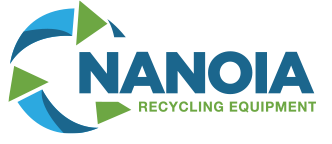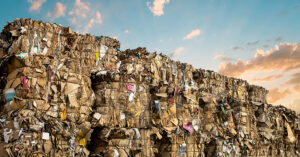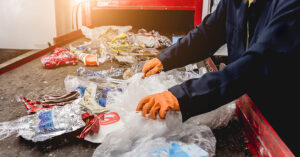In today’s fast-paced business environment, the issue of paper waste has become increasingly significant. As companies continue to expand, so does the volume of paper waste they generate.
Properly managing this waste is not only an environmental responsibility but also a smart business strategy. By implementing effective paper waste management practices, businesses can reduce their carbon footprint, save money, and contribute to a more sustainable future.
In this guide, we will explore what to do with paper waste in your business, from understanding its various types to implementing comprehensive recycling programs.
We’ll also delve into the benefits of using industrial recycling equipment like balers and compactors to optimize your paper waste management process.
Understanding Paper Waste in Businesses
Types of Paper Waste
Businesses generate a variety of paper waste, each requiring different handling and recycling methods. Understanding the types of paper waste is the first step toward effective management:
- Office Paper: This category includes printer paper, shredded documents, and envelopes. Office paper is often of high quality and is typically clean, making it ideal for recycling.
- Packaging Paper: Cardboard boxes and packaging fillers fall into this category. These materials are bulky and often require breaking down before recycling.
- Specialty Paper: This includes glossy, coated, or laminated paper, which may need special recycling processes due to their unique properties.
- Mixed Paper Waste: This is a combination of various types of paper waste, often found together in business settings, such as junk mail, brochures, and magazines.
The Environmental Impact of Improper Paper Waste Management
Improper management of paper waste can have severe environmental consequences:
- Landfill Contribution: A significant portion of paper waste ends up in landfills. In fact, paper and paperboard account for a large percentage of the total waste in landfills. This not only takes up valuable space but also contributes to methane emissions as paper decomposes anaerobically.
- Deforestation: The production of new paper products is directly linked to deforestation. The more paper waste that is not recycled, the greater the demand for virgin paper, leading to more trees being cut down.
- Energy Use in Production: Producing new paper from virgin materials consumes significantly more energy than recycling paper waste. Recycling saves energy and reduces the strain on natural resources.
- Carbon Footprint: The process of manufacturing new paper products emits greenhouse gasses. By recycling paper waste, businesses can significantly lower their carbon footprint.
Steps to Properly Manage Paper Waste in Your Business
Step 1: Reduce Paper Usage
The most effective way to manage paper waste is to reduce the amount of paper used in the first place:
- Digital Solutions: Transitioning to digital documents, cloud storage, and electronic communication can drastically reduce paper consumption. Encourage employees to use digital notes and electronic signatures to minimize paper use.
- Double-Sided Printing: Implementing a policy that promotes double-sided printing can cut paper usage by half. Many modern printers offer this feature as a default setting.
- Paperless Billing: Encourage your customers and vendors to opt for paperless billing. This not only reduces paper waste but also streamlines your business processes.
Step 2: Implementing a Paper Recycling Program
A well-structured recycling program is essential for managing paper waste:
- Internal Collection Systems: Place dedicated bins for paper waste in strategic locations throughout your facility. Ensure that these bins are clearly labeled and easily accessible to encourage use.
- Employee Training and Engagement: Educate your staff on the importance of recycling and provide training on how to properly separate paper waste. Consider hosting workshops or including recycling information in employee handbooks.
- Partnership with Local Recycling Facilities: Establish relationships with local recycling services that can handle your paper waste. These partnerships can simplify the recycling process and ensure that your paper waste is processed correctly.
Step 3: Sorting and Separating Paper Waste
Proper sorting and separation are crucial for efficient recycling:
- Types of Separation:
- White Office Paper: Ensure that this paper is clean, uncoated, and free of contaminants like food or plastic. This type of paper is often highly recyclable and valuable.
- Cardboard and Packaging Paper: Flatten and bundle cardboard boxes to reduce their volume. This makes handling and transportation easier.
- Mixed Paper: Items like magazines, brochures, and other non-sensitive materials can be grouped together for recycling. Ensure that these materials are free from contaminants.
- Contaminated Paper: Paper that has been contaminated with food, chemicals, or other substances should be handled separately. In some cases, it may not be recyclable and will need to be disposed of responsibly.
Step 4: Recycling Paper Waste Onsite with Industrial Equipment
For businesses that generate large volumes of paper waste, investing in industrial recycling equipment can greatly enhance efficiency:
- Balers for Paper Waste:
- Vertical Balers: These are ideal for businesses with smaller volumes of paper waste. They compact paper into manageable bales, making it easier to store and transport.
- Horizontal Balers: Best suited for large-scale operations, horizontal balers offer higher throughput and can handle significant volumes of paper waste.
- Benefits of Balers: Using balers reduces the storage space required for paper waste and makes transportation more cost-effective. Compacted bales are also easier to handle and can fetch higher prices when sold to recyclers.
- Compactors for Mixed Paper Waste:
- Stationary Compactors: These are ideal for businesses with high volumes of mixed waste. They compact waste into dense blocks, reducing the frequency of waste removal.
- Self-Contained Compactors: These units are perfect for paper waste combined with liquid or organic waste, as they prevent leaks and contain odors.
- Advantages: Compactors reduce hauling frequency, leading to cost savings and compliance with waste management regulations. They also enhance workplace cleanliness and safety by reducing waste pile-up.
Best Practices for Maintaining Paper Recycling Equipment
To ensure your recycling equipment operates efficiently and has a long lifespan, it’s important to follow best practices:
- Regular Maintenance: Schedule routine checks to ensure your balers and compactors are operating at peak performance. Regular maintenance helps prevent costly breakdowns and extends the life of your equipment.
- Training for Employees: Proper training ensures that employees know how to safely and effectively use recycling equipment. This includes understanding how to operate the machines, recognize when maintenance is needed, and follow safety protocols.
- Monitoring and Reporting: Track the volume of paper waste being processed and monitor recycling rates. Use these metrics to assess the effectiveness of your recycling program and identify areas for improvement.
The Economic Benefits of Effective Paper Waste Management
Implementing a comprehensive paper waste management strategy can lead to significant economic benefits:
- Reduced Waste Disposal Costs: By reducing the volume of paper waste sent to landfills, businesses can lower waste disposal fees and avoid penalties associated with improper disposal.
- Revenue from Recycled Paper: Many recycling facilities pay for high-quality recycled paper. By sorting and baling your paper waste, you can generate additional revenue for your business.
- Increased Operational Efficiency: Streamlined waste handling processes free up resources and time, allowing your business to operate more efficiently. This can lead to cost savings and improved productivity.
Why Choose Nanoia Recycling Equipment for Your Paper Waste Management Needs
At Nanoia Recycling Equipment, we offer comprehensive solutions for all your paper waste management needs. From design and fabrication to delivery, installation, financing, and repair, we handle every aspect of the recycling process.
Our custom equipment solutions are tailored to meet the specific needs of your business, ensuring that you can manage your paper waste efficiently and effectively.
Our expert support and maintenance services ensure that your recycling program runs smoothly, minimizing downtime and maximizing the lifespan of your equipment.
Ready to optimize your paper waste management? Contact Nanoia Recycling Equipment today for a custom solution that will help your business achieve its sustainability goals while improving operational efficiency.






